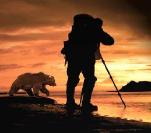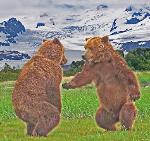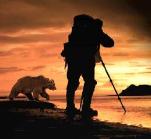Glacial Ice Shelves and Ice Bergs
| Glacial Moraines |













Due to the great weight of a glacier, sometimes tons per sq. yard/meter, its foot bulldozes up the ground -- including bedrock. The broken earth
pushed ahead of the glacier is known as "end moraine;" that which slips off to either side of the dozer is "lateral moraine." If there is only a
single glacier flowing down a valley, there is just one pair of lateral moraines and one end moraine, as shown above at left.
pushed ahead of the glacier is known as "end moraine;" that which slips off to either side of the dozer is "lateral moraine." If there is only a
single glacier flowing down a valley, there is just one pair of lateral moraines and one end moraine, as shown above at left.
When glaciers merge, if they are of similar size, their medial moraine tends to be in the center of the combined glacier. But if one glacier is
much stronger than the other, the combined medial moraine is closest to the side of the valley from which the weaker glacier emerged.
much stronger than the other, the combined medial moraine is closest to the side of the valley from which the weaker glacier emerged.
However, when glaciers converge from two valleys, each with its own end and lateral moraines, their juncture creates a "medial" moraine running
However, when glaciers converge from two valleys, each with its own end and lateral moraines, their juncture creates a "medial" moraine running
from the right. As seen from this orientation: The right-hand lateral moraine of the left-hand glacier, plus the left-hand moraine of the right-hand
down the "middle" of the glacier below their junction point. In the diagram at left, near the top of the valley, two glaciers join, one from the left, one
glacier forma a medial moraine starting just below the juncture of the two smaller glaciers. Likewise, as a third glacier enters from the right, then a
fourth (blue banded) glacier enters from the left, additional medial moraines are formed. The number of medial moraines is typically 2 less than the
number of glaciers which have merged.
However, when glaciers converge from two valleys, each with its own end and lateral moraines, their juncture creates a "medial" moraine running
from the right. As seen from this orientation: The right-hand lateral moraine of the left-hand glacier, plus the left-hand moraine of the right-hand
down the "middle" of the glacier below their junction point. In the diagram at left, near the top of the valley, two glaciers join, one from the left, one
glacier forma a medial moraine starting just below the juncture of the two smaller glaciers. Likewise, as a third glacier enters from the right, then a
fourth (blue banded) glacier enters from the left, additional medial moraines are formed. The number of medial moraines is typically 2 less than the
number of glaciers which have merged.
Rock fragments in moraine can vary in size from dust to huge boulders. This "glacial till" is sometimes carried downhill many miles/km from its
point of origin. As a result, even enormous boulders are sometimes found stranded, on the ground or sticking out of it (above right). Such
boulders are called "glacial erratics." Erratics can often be recognized because they lie far from any similar bedrock, and because their surface
may be scored with parallel, relatively horizontal lines, made as smaller rocks in the glacier were pushed past the erratic and scraped against it.
If the boulder overlies softer rock, it can shield that softer rock from rainfall erosion, even as surrounding softer rock is gradually worn away. The
result can be a mushroom-like formation with a boulder balanced on a column of softer rock, as shown above, right.
point of origin. As a result, even enormous boulders are sometimes found stranded, on the ground or sticking out of it (above right). Such
boulders are called "glacial erratics." Erratics can often be recognized because they lie far from any similar bedrock, and because their surface
may be scored with parallel, relatively horizontal lines, made as smaller rocks in the glacier were pushed past the erratic and scraped against it.
If the boulder overlies softer rock, it can shield that softer rock from rainfall erosion, even as surrounding softer rock is gradually worn away. The
result can be a mushroom-like formation with a boulder balanced on a column of softer rock, as shown above, right.
If a glacier advances, retreats, and advances again repeatedly, with each advance shorter than the previous one(s), it can produce a series of
end moraines. The farthest one away from the head of the glacier, is known as its "terminal moraine."
end moraines. The farthest one away from the head of the glacier, is known as its "terminal moraine."
If an end moraine runs completely across a valley, it can act as a dam, trapping melt water from the glacier and forming a terminal lake.
The white dots in the glacial lake at right are icebergs calved off the glacier.
The white dots in the glacial lake at right are icebergs calved off the glacier.
Glacial moraines
Site Visit Counter


Typical glacial till in the
lowlands seaward from
the Chigmiut Mountains
and across Cook Inlet
on the Kenai Peninsula.
End moraine.
lowlands seaward from
the Chigmiut Mountains
and across Cook Inlet
on the Kenai Peninsula.
End moraine.
If the relative strengths of the two glaciers remain constant over long periods, then the medial moraine they form tends to parallel the lateral In the
photo below left (Alaska's Black Glacier), tributary glaciers from the left have, at times, been so much stronger than the main valley glacier, that
they have pushed out to the right more than half-way across the main valley, before being pushed back left again, causing their medial moraines
glacier. The valley shown above, right, has receive influx from so many tributary glaciers, whose strengths have varied so dramatically over time,
that their medial moraines writhe and twist like a nest of snakes.
photo below left (Alaska's Black Glacier), tributary glaciers from the left have, at times, been so much stronger than the main valley glacier, that
they have pushed out to the right more than half-way across the main valley, before being pushed back left again, causing their medial moraines
glacier. The valley shown above, right, has receive influx from so many tributary glaciers, whose strengths have varied so dramatically over time,
that their medial moraines writhe and twist like a nest of snakes.
| Bear Viewing Association To watch, to wonder, and to conserve [email protected] Ph/Fax (907) 260-9059 (Office) 39200 Alma Ave. Soldotna, AK 99669 |


| Bear Viewing Association To watch, to wonder, and to conserve [email protected] Ph/Fax (907) 260-9059 (Office) 39200 Alma Ave. Soldotna, AK 99669 |


| Glaciers, Glacial Landscapes, and Their Roles in the Ecology of Alaskan Bears |